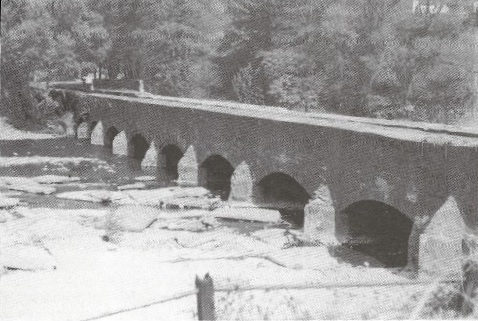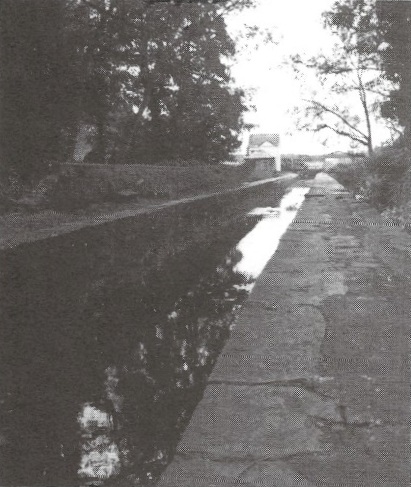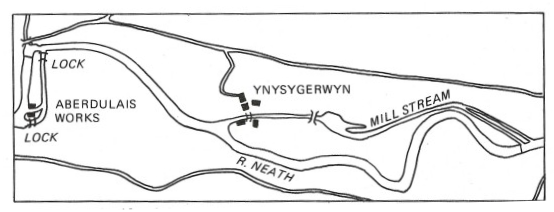
Neath Antiquarian Society Transactions 1978
The Two Aqueducts at Aberdulais
Source: Neath Antiquarian Society Neath Antiquarian Society Transactions 1978.
The draining of the ten-arched aqueduct of the Tennant Canal at Aberdulais revealed a secret long since hidden and forgotten — the earliest canal known to us in Wales.
This was referred to in a 1760 lease from Herbert Mackworth which mentions the lock which was part of the canal as standing on his land and near a farm of Mr. Vernon’s. (George Venables Vernon, Esq. had given a lease in 1759 for Aberdulais Fach Farm to a Griffith Jenkins on the lives of his wife Elizabeth and son Elias.) There was also a lease of 1768 mentioning Forge houses and this navigable cut through Aberdulais Fach farm.
It is on record that there was an iron-forge at Aberdulais by 1667 on the site of an earlier copper works.
Copper ore from Cornwall had been brought by ‘waies necessary for carriages to the works’ and kept in good condition by the express wish in writing of Elizabeth 1st.
Transport by water was difficult because although the high tides in the River Neath bring an increase of water as far as ‘the bend’ at Aberdulais, the shallowness of the river higher up made it impossible to import ores directly by water to the works — until this navigable cut was made.
In C. Hadfield’s ‘Canals of South Wales and the Border’* he says, “Sir Humphrey Mackworth had also since that time (June 1699) made a cut or canal from the Neath River of about 18-20 feet wide and 300 yards long in which trows and small vessels with 30 tons might come up within 400 yards of the smelting and refining houses and that a strong crane was also erected and the partners goods unloaded there.”

The remaining impression of this navigable cut at Aberdulais can still be seen running parallel with the river and under the 23ft iron trough used by Kirkhouse to carry the Tennant Canal over the cut.
Telford had used a similar technique to take the Shrewsbury Canal over the River Tern for the Danby family. This iron trough is the second aqueduct at Aberdulais; the other next to it carrying the canal by means of ten arches over the River Neath.
This cut was providing a supply of water for the iron forges and later the Aberdulais Tinworks on the site now occupied by the Calor Gas Works.
One of the two railway arches near ‘The Railway Tavern’ was built to provide a passageway for this canal to continue under a later road and into the works site.
In order to make full use of transport by water, weirs were made across the River Neath in 1723.
One below the junction of the River Dulais in to the Neath River and the other at Ynysbwllog.
The weirs made it possible for a mill stream to give power to the rolling and tinplate works at Ynysygerwn and also for barges to transport iron bars from the Aberdulais ironworks to be tinned at Ynysygerwn.
A new bridge from Tonna to the Aberdulais side was also shown on Kitchen’s Map, 1754. It is of interest to note how this piece of ground came to be used by Lord Vernon.
It was not bought but inherited through the Briton Ferry Estate although the land surrounding belonged to the Gnoll Estate.
Leases are recorded which show this area lefts in the will of David Evans from the Gnoll Estate to his wife Catherine as a close called ‘Y towarchen Fach’ and shares a field called ‘towarchen fawr’.
The names ‘towarchen’ and ‘dewarden’ were from the Welsh ‘Twr ar y don’ – the mound or moraine on the Ton mountain.
This area had become part of the Briton Ferry Inheritance after the marriage of their daughter Maude (Marie) to David Evans’ cousin Leison Price.

REFERENCES
- a) 1760 Lease from Herbert Mackworth, Esq. for Tylerdwr on Dulais Forge on which part of the lock stands 34 acre adjoining farm of Mr. Vernon and Tylercoed. £7. b) A new lease of 1768 from George Venables Vernon, Esq. of Dulais Forge Houses and Smith’s Forge Coal House and Navigable cut thro’ Aberdulais Vach Farm from Lady day 1768 for 21 years. £5 We also know from a lease of 1759 that Aberdulais Fach farm near Dulais Forge was occupied by agent Griffith Jenkins, his wife Elizabeth and son Elias. (Rhys Phillips, ‘History of Vale of Neath’. p. 697
- ‘Neath and District a Symposium’ edited by Elis Jenkins ‘Copper Industry’ by Clive Trott. p. 113
- ‘Canals of S. Wales and the Border’ C. Hadfield, 1960 р. 64
- ‘Shropshire History Makers’ Dorothy P. H. Wren, p. 56.
5.”Telford had already constructed a small aqueduct. In 1795 he was asked to complete the Shrewsbury Canal which linked the town to the coalmines at Ketley. At one point the Canal had to cross the River Tern and this Telford accomplished by the use of an iron trough cemented into a low stone bridge.” Neath and District – Symposium ‘Iron Industry’ quoting Warner. - D. Rhys Phillips, ‘History of the Vale of Neath’, 1925. Wills. р. 762.
- Antiquarian Transactions, 1980 David Evans’ will (Gnoll) …..To Katherine my wife a close called ‘ye towarchen vach… all my interests in meadow called ye towarchen vawr. The moiety of the fishery in Neath River. To Maud (daughter) £200 in two instalments on condition she takes as husband my cousin Leyson Prees otherwise to have grange of White Cross.